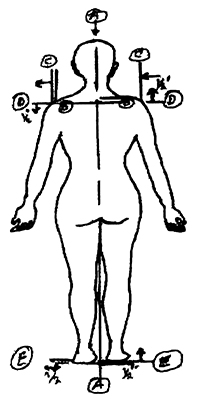American Farriers Journal
American Farriers Journal is the “hands-on” magazine for professional farriers, equine veterinarians and horse care product and service buyers.
Editor’s Note: Bob Peacock, a master farrier from Hamilton, Ohio, believes that many cases of navicular syndrome have as much to do with the rider as they do with the horse. He has developed the following test to help determine if a horse’s balance problem may be related to its rider’s balance problem. He’s based this on years of observation of horses and riders.
Look at the rider standing on the ground, arms at his or her side. Imagine a centerline running between the ears at the nose (Figure 1, Line A).
Imagine another line perpendicular to the neck and intersecting the shoulders (Figure 1, Line B). Look at the distance from the point of the top of the shoulder to the centerline. It should be the same length (Figure 1, Line C).
Check the height of the shoulders. They should be the same. If they are not on the same level plane, the rider should have the stirrups on the saddle adjusted to compensate (Figure 1, Line D).
To test this, use a 4-by-6-inch wooden block that is 1/2- to 3/4-inch thick. Place it on the ground between the rider’s feet. Have him or her stand with the right foot on the block and the left foot relaxed on the ground. Look at the shoulders. Do you notice a change in the plane of the shoulders?

Figure 1.
Then place the block of wood under the opposite foot. Look again at the shoulders. Notice the change? If…